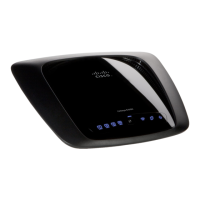30
Wireless-N Router
Linksys E1000 Chapter 3: Advanced Configuration
your network must support Wireless WMM. To disable
this option, select Disabled. Otherwise, keep the default,
Enabled.
No Acknowledgement If you want to disable the
Router’s Acknowledgement option, so the Router will
not re-send data if an error occurs, then select Enabled.
Otherwise, keep the default, Disabled.
Internet Access Priority
In this section, you can set the bandwidth priority for a
variety of applications and devices. There are four levels
of priority: High, Medium, Normal, or Low. When you
set priority, do not set all applications to High, because
this will defeat the purpose of allocating the available
bandwidth. If you want to select below normal bandwidth,
select Low. Depending on the application, a few attempts
may be needed to set the appropriate bandwidth priority.
Enabled/Disabled To use the QoS policies you set, select
Enabled. Otherwise, keep the default, Disabled.
Upstream Bandwidth This option sets the maximum
outgoing bandwidth that applications can use. To allow
the Router to set the maximum, keep the default, Auto.
To specify the maximum, select Manual and enter the
bandwidth.
Category
You can define the Internet access priority level for as
many categories as you want. The Summary section will
display all of the priority selections that you enter. Select
from the following categories:
• Applications Allows you to assign a priority level for a
pre-defined application or one that you add.
• Online Games Allows you to assign a priority level for
a pre-defined game or one that you add.
• MAC Address This option lets you prioritize network
traffic based on the device that is accessing the
network. For example, if you want your gaming
console to have higher priority accessing the Internet
than your computer, you can assign their priority levels
using their respective MAC addresses.
• Voice Device Voice devices require a higher priority
level. You can assign a higher priority level to voice
devices using their respective MAC addresses.
Summary
This lists the QoS entries you have created for your
applications and devices. Refer to Summary, page 31 for
more information.
Applications
Applications Select the appropriate application. If you
select Add a New Application, follow the instructions in
the Add a New Application section.
Priority Select the appropriate priority: High, Medium
(Recommend), Normal, or Low.
Click Add to save your changes. Your new entry will appear
in the Summary list.
Add a New Application
QoS > Add a New Application
Enter a Name Enter a name for this application.
Port Range Enter the port range that the application will
be using. For example, if you want to allocate bandwidth
for FTP, you can enter 21-21. If you need services for an
application that uses from 1000 to 1250, you enter 1000-
1250 as your settings. You can have up to three ranges
to define for this bandwidth allocation. Port numbers
can range from 1 to 65535. Check your application’s
documentation for details on the service ports used.
Select the protocol TCP or UDP, or select Both.
Priority Select the appropriate priority: High, Medium
(Recommend), Normal, or Low.
Click Add to save your changes. Your new entry will appear
in the Summary list.
Online Games
QoS > Online Games
Game Select the appropriate game. If you select Add a
New Game, follow the instructions in the Add a New Game
section.
Priority Select the appropriate priority: High, Medium
(Recommended), Normal, or Low.
Click Add to save your changes. Your new entry will appear
in the Summary list.

